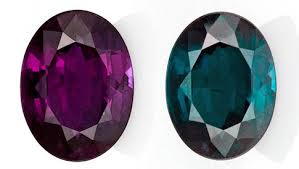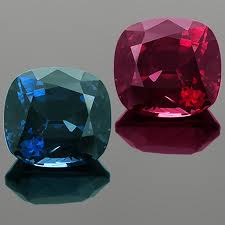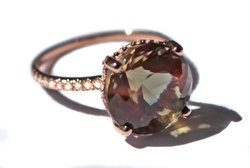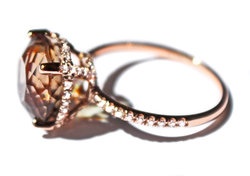We all know how important light is to how we view the world. From bad fluorescent lighting your bathroom to the sublime sunlight of a Tuscan afternoon, our moods & perceptions are all based on the light around us. Without getting too involved with the physics, it is helpful to know that the “color” of normal incandescent light (these bulbs may soon be come extinct due to their relatively inefficient nature) is 2700-3300 Kelvin while natural sunlight at noon at the equator is 5000-6500K. Many LCDs are in the 6500-10,000K range, which make them look cool or bluish. Jewelry showcases are often fitted with lights in the 5000+K area to make the gemstones (especially diamonds) look brighter. So the color of the light striking the gemstone is very important to how it looks. One of the most interesting phenomena is color change and color shifting gemstones.
A color change stone literally changes color depending on the wavelength of the light that hits it. The most famous example is the alexandrite, which looks reddish-purple in incandescent and changes to greenish-brown in natural sunlight. Alexandrites are usually small (less than 2 ct) & quite expensive with the price depending on the “percent” of color change observed & the size.
Recently, some garnets from Africa also exhibit alexandrite-like color change, changing from red in incandescent light to green-blue in sunlight. Although usually cheaper than alexandrites, they can command high prices, again depending on the percent of color change observed & the size of the stone.
A color shift stone changes its color when rotated in a constant light. The newest example of this is the Oregon Sun Stone. The color shifts vary considerably, with some stones having no shift and others having shifts among 3 colors. The base colors of these stones are variable as well. This stone below shifts from greenish brown to pinkish peach when the stone is rotated.
This ring can be found here.
Stones that flash different colors at the same time are called dichroic and trichroic, but that is a topic for another blog!




